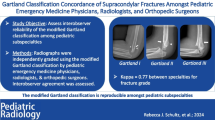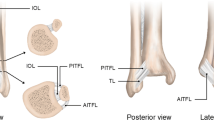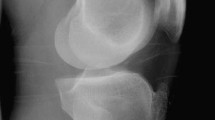Abstract
Objectives
The purpose of this agreement was to establish evidence-based consensus statements on imaging of distal radioulnar joint (DRUJ) instability and triangular fibrocartilage complex (TFCC) injuries by an expert group using the Delphi technique.
Methods
Nineteen hand surgeons developed a preliminary list of questions on DRUJ instability and TFCC injuries. Radiologists created statements based on the literature and the authors’ clinical experience. Questions and statements were revised during three iterative Delphi rounds. Delphi panelists consisted of twenty-seven musculoskeletal radiologists. The panelists scored their degree of agreement to each statement on an 11-item numeric scale. Scores of “0,” “5,” and “10” reflected complete disagreement, indeterminate agreement, and complete agreement, respectively. Group consensus was defined as a score of “8” or higher for 80% or more of the panelists.
Results
Three of fourteen statements achieved group consensus in the first Delphi round and ten statements achieved group consensus in the second Delphi round. The third and final Delphi round was limited to the one question that did not achieve group consensus in the previous rounds.
Conclusions
Delphi-based agreements suggest that CT with static axial slices in neutral rotation, pronation, and supination is the most useful and accurate imaging technique for the work-up of DRUJ instability. MRI is the most valuable technique in the diagnosis of TFCC lesions. The main indication for MR arthrography and CT arthrography are Palmer 1B foveal lesions of the TFCC.
Clinical relevance statement
MRI is the method of choice for assessing TFCC lesions, with higher accuracy for central than peripheral abnormalities. The main indication for MR arthrography is the evaluation of TFCC foveal insertion lesions and peripheral non-Palmer injuries.
Key points
• Conventional radiography should be the initial imaging technique in the assessment of DRUJ instability. CT with static axial slices in neutral rotation, pronation, and supination is the most accurate method for evaluating DRUJ instability.
• MRI is the most useful technique in diagnosing soft-tissue injuries causing DRUJ instability, especially TFCC lesions.
• The main indications for MR arthrography and CT arthrography are foveal lesions of the TFCC.






Similar content being viewed by others
Abbreviations
- CT:
-
Computed tomography
- DOB:
-
Distal oblique band of the interosseous membrane
- DRUJ:
-
Distal radioulnar joint
- ECU:
-
Extensor carpi ulnaris
- IQR:
-
Interquartile range
- I-WRIST 2021:
-
International Wrist Radiologic evaluation for the Instability of the Scapholunate and DRUJ/TFCC
- MRI:
-
Magnetic resonance imaging
- TFCC:
-
Triangular fibrocartilage complex
References
Gulati A, Wadhwa V, Ashikyan O, Cerezal L, Chhabra A (2019) Current perspectives in conventional and advanced imaging of the distal radioulnar joint dysfunction: review for the musculoskeletal radiologist. Skeletal Radiol 48(3):331–348
Amrami KK, Moran SL, Berger RA, Ehman EC, Felmlee JP (2010) Imaging the distal radioulnar joint. Hand Clin 26(4):467–475
Nakamura T (2012) Anatomy and biomechanics of the distal radioulnar joint (DRUJ). In: del Piñal F, Mathoulin C, Nakamura T (eds) Arthroscopic Management of Ulnar Pain. Springer, Heidelberg, pp 15–23
Kleinman WB (2007) Stability of the distal radioulna joint: biomechanics, pathophysiology, physical diagnosis, and restoration of function what we have learned in 25 years. J Hand Surg Am 32(7):1086–1106
Cerezal L, de Dios B-M, Canga A et al (2012) MR and CT arthrography of the wrist. Semin Musculoskelet Radiol 16(1):27–41
Cody ME, Nakamura DT, Small KM, Yoshioka H (2015) MR imaging of the triangular fibrocartilage complex. Magn Reson Imaging Clin N Am 23(3):393–403
Kirchberger MC, Mühldorfer-Fodor M, Hahn P et al (2015) Update TFCC: histology and pathology, classification, examination and diagnostics. Arch Orthop Trauma Surg 135(3):427–437
Jens S, Luijkx T, Smithuis FF, Maas M (2017) Diagnostic modalities for distal radioulnar joint. J Hand Surg Eur Vol 42(4):395–404
Lee RK, Ng AW, Tong CS et al (2013) Intrinsic ligament and triangular fibrocartilage complex tears of the wrist: comparison of MDCT arthrography, conventional 3-T MRI, and MR arthrography. Skeletal Radiol 42(9):1277–1285
Moser T, Khoury V, Harris PG, Bureau NJ, Cardinal E, Dosch JC (2009) MDCT arthrography or MR arthrography for imaging the wrist joint? Semin Musculoskelet Radiol 13(1):39–54
Wang ZX, Chen SL, Wang QQ et al (2015) The performance of magnetic resonance imaging in the detection of triangular fibrocartilage complex injury: a meta-analysis. J Hand Surg Eur Vol 40(5):477–484
Treiser MD, Crawford K, Iorio ML (2018) TFCC injuries: meta-analysis and comparison of diagnostic imaging modalities. J Wrist Surg 7(3):267–272
Dietrich TJ, Toms AP, Cerezal L et al (2021) Interdisciplinary consensus statements on imaging of scapholunate joint instability. Eur Radiol 31(12):9446–9458
Palmer AK (1989) Triangular fibrocartilage complex lesions: a classification. J Hand Surg Am 14:594–606
Atzei A (2009) New trends in arthroscopic management of type 1-B TFCC injuries with DRUJ instability. J Hand Surg Eur Vol 34(5):582–591
Atzei A, Luchetti R (2011) Foveal TFCC tear classification and treatment. Hand Clin 27(3):263–272
Atzei A, Luchetti R, Garagnani L (2017) Classification of ulnar triangular fibrocartilage complex tears. A treatment algorithm for Palmer type IB tears. J Hand Surg Eur Vol 42(4):405–414
del Piñal F (2012) The 1B Constellation: an attempt to classify Palmer 1B class. In: del Piñal F, Mathoulin C, Nakamura T (eds) Arthroscopic management of ulnar pain. Springer, Heidelberg, pp 87–97
Oxford Centre for Evidence-Based Medicine 2011 Levels of Evidence (2011) Centre for Evidence-Based Medicine, Oxford. Available via https://www.cebm.net/wp-content/uploads/2014/06/CEBM-Levels-of-Evidence-2.1.pdf. Accessed January 14, 2021
Steurer J (2011) The Delphi method: an efficient procedure to generate knowledge. Skeletal Radiol 40(8):959–961
von der Gracht HA (2012) Consensus measurement in Delphi studies: review and implications for future quality assurance. Technol Forecast Soc Chang 79:1525–1536
Diamond IR, Grant RC, Feldman BM et al (2014) Defining consensus: a systematic review recommends methodologic criteria for reporting of Delphi studies. J Clin Epidemiol 67(4):401–409
Mascarenhas VV, Castro MO, Rego PA et al (2020) The Lisbon Agreement on Femoroacetabular Impingement Imaging-part 1: overview. Eur Radiol 30:5281–5297
Tolat AR, Stanley JK, Trail IA (1996) A cadaveric study of the anatomy and stability of the distal radioulnar joint in the coronal and transverse planes. J Hand Surg Br 21(5):587–994
af Ekenstam F, Hagert CG (1985) Anatomical studies on the geometry and stability of the distal radio ulnar joint. Scand J Plast Reconstr Surg 19(1):17–25
Wallwork NA, Bain GI (2001) Sigmoid notch osteoplasty for chronic volar instability of the distal radioulnar joint: a case report. J Hand Surg Am 26:454–459
Watanabe H, Berger RA, An KN, Berglund LJ, Zobitz ME (2004) Stability of the distal radioulnar joint contributed by the joint capsule. J Hand Surg Am 29(6):1114–1120
Mespreuve M, Vanhoenacker F, Verstraete K (2015) Imaging findings of the distal radio-ulnar joint in trauma. J Belg Soc Radiol 99(1):1–20
Carr R, MacLean S, Slavotinek J, Bain GI (2019) Four-dimensional computed tomography scanning for dynamic wrist disorders: prospective analysis and recommendations for clinical utility. J Wrist Surg 8(2):161–167
Hess F, Sutter R, Nagy L, Schweizer A (2016) Stability and clinical outcome after reconstruction of complete triangular fibrocartilage disruption. J Wrist Surg 5(2):124–130
Cerezal L, del Piñal F, Abascal F, García-Valtuille R, Pereda T, Canga A (2002) Imaging findings in ulnar-sided wrist impaction syndromes. Radiographics 22(1):105–121
Serfaty A, Costa HP, Foelker CE, Filho ENK, Souza FF, Bordalo-Rodrigues M (2020) Evaluation of ulnar variance on wrist MR imaging: is it a reliable measure? Skeletal Radiol 49(5):723–730
Laino DK, Petchprapa CN, Lee SK (2012) Ulnar variance: correlation of plain radiographs, computed tomography, and magnetic resonance imaging with anatomic dissection. J Hand Surg Am 37(1):90–97
Zhan H, Bai R, Qian Z, Yang Y, Zhang H, Yin Y (2020) Traumatic injury of the triangular fibrocartilage complex (TFCC)-a refinement to the Palmer classification by using high-resolution 3-T MRI. Skeletal Radiol 49(10):1567–1579
Nozaki T, Rafijah G, Yang L et al (2017) High-resolution 3 T MRI of traumatic and degenerative triangular fibrocartilage complex (TFCC) abnormalities using Palmer and Outerbridge classifications. Clin Radiol 72(10):904.e1-904.e10
Lee YH, Choi YR, Kim S, Song HT, Suh JS (2013) Intrinsic ligament and triangular fibrocartilage complex (TFCC) tears of the wrist: comparison of isovolumetric 3D-THRIVE sequence MR arthrography and conventional MR image at 3 T. Magn Reson Imaging 31(2):221–226
Magee T (2009) Comparison of 3-T MRI and arthroscopy of intrinsic wrist ligament and TFCC tears. AJR Am J Roentgenol 192(1):80–85
Petsatodis E, Pilavaki M, Kalogera A, Drevelegas A, Agathangelidis F, Ditsios K (2019) Comparison between conventional MRI and MR arthrography in the diagnosis of triangular fibrocartilage tears and correlation with arthroscopic findings. Injury 50(8):1464–1469
Bille B, Harley B, Cohen H (2007) A comparison of CT arthrography of the wrist to findings during wrist arthroscopy. J Hand Surg Am 32(6):834–841
De Filippo M, Pogliacomi F, Bertellini A et al (2010) MDCT arthrography of the wrist: diagnostic accuracy and indications. Eur J Radiol 74(1):221–225
Schmitt R, Christopoulos G, Meier R et al (2003) Direct MR arthrography of the wrist in comparison with arthroscopy: a prospective study on 125 patients. Rofo 175(7):911–919
Smith TO, Drew B, Toms AP, Jerosch-Herold C, Chojnowski AJ (2012) Diagnostic accuracy of magnetic resonance imaging and magnetic resonance arthrography for triangular fibrocartilaginous complex injury: a systematic review and meta-analysis. J Bone Joint Surg Am 94(9):824–832
Andersson JK, Andernord D, Karlsson J, Fridén J (2015) Efficacy of magnetic resonance imaging and clinical tests in diagnostics of wrist ligament injuries: a systematic review. Arthroscopy 31(10):2014–2020
Nakamura T, Makita A (2000) The proximal ligamentous component of the triangular fibrocartilage complex. J Hand Surg Br 25(5):479–486
Haugstvedt JR, Berger RA, Nakamura T, Neale P, Berglund L, An KN (2006) Relative contributions of the ulnar attachments of the triangular fibrocartilage complex to the dynamic stability of the distal radioulnar joint. J Hand Surg Am 31(3):445–451
Ehman EC, Hayes ML, Berger RA, Felmlee JP, Amrami KK (2011) Subluxation of the distal radioulnar joint as a predictor of foveal triangular fibrocartilage complex tears. J Hand Surg Am 36(11):1780–1784
Zhan H, Zhang H, Bai R, Qian Z, Liu Y, Zhang H, Yin Y (2017) High-resolution 3-T MRI of the triangular fibrocartilage complex in the wrist: injury pattern and MR features. Skeletal Radiol 46(12):1695–1706
Ringler MD (2013) MRI of wrist ligaments. J Hand Surg 38(10):2034–2046
Haims AH, Schweitzer ME, Morrison WB et al (2002) Limitations of MR imaging in the diagnosis of peripheral tears of the triangular fibrocartilage of the wrist. AJR Am J Roentgenol 178(2):419–422
Rüegger C, Schmid MR, Pfirrmann CW, Nagy L, Gilula LA, Zanetti M (2007) Peripheral tear of the triangular fibrocartilage: depiction with MR arthrography of the distal radioulnar joint. AJR Am J Roentgenol 188(1):187–192
Moritomo H, Arimitsu S, Kubo N, Masatomi T, Yukioka M (2015) Computed tomography arthrography using a radial plane view for the detection of triangular fibrocartilage complex foveal tears. J Hand Surg Am 40(2):245–251
Grunz J-P, Gietzen CH, Luetkens K et al (2020) The importance of radial multiplanar reconstructions for assessment of triangular fibrocartilage complex injury in CT arthrography of the wrist. BMC Musculoskelet Disord 21(1):286
Bednar MS, Arnoczky SP, Weiland AJ (1991) The microvasculature of the triangular fibrocartilage complex: its clinical significance. J Hand Surg 16(6):1101–1105
Tanaka T, Yoshioka H, Ueno T, Shindo M, Ochiai N (2006) Comparison between high-resolution MRI with a microscopy coil and arthroscopy in triangular fibrocartilage complex injury. J Hand Surg Am 31(8):1308–1314
Ringler MD, Howe BM, Amrami KK, Hagen CE, Berger RA (2013) Utility of magnetic resonance imaging for detection of longitudinal split tear of the ulnotriquetral ligament. J Hand Surg Am 38(9):1723–1727
Nakamura T (2010) Radial side tear of the triangular fibrocartilage complex. In: del Piñal F, Mathoulin C, Luchetti R (eds) Arthroscopic management of distal radius fractures. Springer, Heidelberg, pp 89–98
Morisawa Y, Nakamura T, Tazaki K (2007) Dorsoradial avulsion of the triangular fibrocartilage complex with an avulsion fracture of the sigmoid notch of the radius. J Hand Surg European 32(6):705–708
Estrella EP, Hung LK, Ho PC, Tse WL (2007) Arthroscopic repair of triangular fibrocartilage complex tears. Arthroscopy 23(7):729–737
Abe Y, Tominaga Y, Yoshida K (2012) Various patterns of traumatic triangular fibrocartilage complex tear. Hand Surg 17(2):191–198
Schmitt R, Grunz JP, Langer M (2022) Triangular fibrocartilage complex injuries - limitations of the current classification systems and the proposed new “CUP” classification. J Hand Surg Eur Vol 13:17531934221121932
Jose J, Arizpe A, Barrera CM et al (2018) MRI findings in bucket-handle tears of the triangular fibrocartilage complex. Skeletal Radiol 47(3):419–424
Boutin RD, Fritz RC (2021) Displaced flap tears of the triangular fibrocartilage complex: frequency, flap Location, and the “comma” sign on wrist MRI. AJR Am J Roentgenol 217(3):707–708
Abe Y, Moriya A, Tominaga Y, Yoshida K (2016) Dorsal tear of triangular fibrocartilage complex: clinical features and treatment. J Wrist Surg 5(1):42–46
Haugstvedt JR, Søreide E (2017) Arthroscopic management of triangular fibrocartilage complex peripheral injury. Hand Clin 33(4):607–618
Kim YH, Gong HS, Park JW et al (2017) Magnetic resonance imaging evaluation of the distal oblique bundle in the distal interosseous membrane of the forearm. BMC Musculoskelet Disord 18(1):47
Okada K, Moritomo H, Miyake J et al (2014) Morphological evaluation of the distal interosseous membrane using ultrasound. Eur J Orthop Surg Traumatology 24(7):1095–1100
MacLennan AJ, Nemechek NM, Waitayawinyu T, Trumble TE (2008) Diagnosis and anatomic reconstruction of extensor carpi ulnaris subluxation. J Hand Surg Am 33(1):59–64
Jeantroux J, Becce F, Guerini H et al (2011) Athletic injuries of the extensor carpi ulnaris subsheath: MRI findings and utility of gadolinium-enhanced fat-saturated T1-weighted sequences with wrist pronation and supination. Eur Radiol 21(1):160–166
Luijkx T, Buckens CF, van Seeters T, Pegge SA, Maas M (2019) ECU tendon subluxation: a nonspecific MRI finding occurring in all wrist positions irrespective of ulnar-sided symptoms? Eur J Radiol 116:192–197
Petchprapa CN, Meraj S, Jain N (2016) ECU tendon “dislocation” in asymptomatic volunteers. Skeletal Radiol 45(6):805–812
Lee KS, Ablove RH, Singh S et al (2009) Ultrasound imaging of normal displacement of the extensor carpi ulnaris tendon within the ulnar groove in 12 forearm–wrist positions. AJR Am J Roentgenol 193(3):651–655
Funding
This study has received funding by The European Society of Musculoskeletal Radiology, which covered the expenses for the statistician of the I-WRIST 2021 interdisciplinary consensus statement project.
Author information
Authors and Affiliations
Corresponding author
Ethics declarations
Guarantor
The scientific guarantor of this publication is Luis Cerezal (first author), Iwona Sudoł-Szopińska and Tobias Dietrich (senior authors).
Conflict of interest
The authors of this manuscript declare no relationships with any companies whose products or services may be related to the subject matter of the article.
Statistics and biometry
Małgorzata Mańczak kindly provided statistical advice for this manuscript.
Informed consent
Written informed consent was not required for this study because neither patients nor volunteers were directly included as participants.
Ethical approval
Institutional Review Board approval was not required because required because patients nor volunteers were directly included as participants. Thus, Institutional Review Board approval was not required because the present study fulfills the conditions for not requiring official approval for operation according the Swiss Federal Act on Research Involving Human Beings (Human Research Act).
Methodology
• prospective
• not applicable
• multicenter study
Additional information
Publisher's note
Springer Nature remains neutral with regard to jurisdictional claims in published maps and institutional affiliations.
Supplementary Information
Below is the link to the electronic supplementary material.
Rights and permissions
Springer Nature or its licensor (e.g. a society or other partner) holds exclusive rights to this article under a publishing agreement with the author(s) or other rightsholder(s); author self-archiving of the accepted manuscript version of this article is solely governed by the terms of such publishing agreement and applicable law.
About this article
Cite this article
Cerezal, L., del Piñal, F., Atzei, A. et al. Interdisciplinary consensus statements on imaging of DRUJ instability and TFCC injuries. Eur Radiol 33, 6322–6338 (2023). https://doi.org/10.1007/s00330-023-09698-7
Received:
Revised:
Accepted:
Published:
Issue Date:
DOI: https://doi.org/10.1007/s00330-023-09698-7




